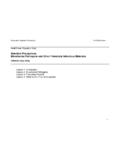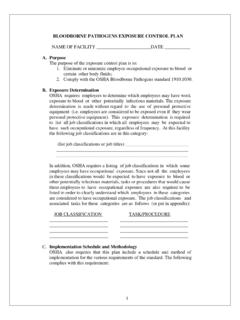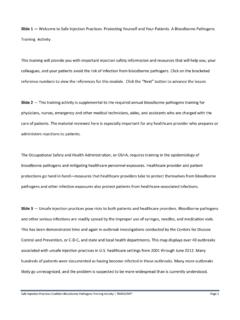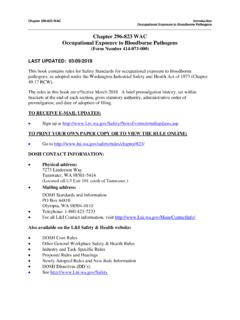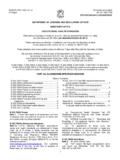Transcription of OSHA BBP Exp-Control Plan Instruction-FINAL
1 ABSTRACT - 1 DIRECTIVE NUMBER: CPL 02-02-077 EFFECTIVE DATE: September 27, 2010 SUBJECT: bloodborne pathogens Exposure control plan and Guidance on Post-Exposure Evaluations for Federal OSHA Personnel ABSTRACT Purpose: This instruction provides a uniform policy and guidance for protecting Federal OSHA personnel from bloodborne pathogens or other potentially infectious materials (OPIM). Scope: This instruction applies OSHA-wide. References: 1. 29 CFR bloodborne pathogens . 2. 29 CFR Access to employee exposure and medical records. Cancellations: 1. Instruction CPL 02-02-060, Exposure control plan for OSHA Personnel with Occupational Exposure to bloodborne pathogens 2. Memorandum from Edwin G. Foulke, Jr. to Regional Administrators, October 2, 2007, Subject: OSHA s bloodborne pathogens Policy on Hepatitis B Vaccination of CSHOs State Impact: This instruction describes a Federal Program for which state adoption is not required.
2 (See paragraph IV) Action Offices: OSHA Regional Offices, Area Offices and National Offices Originating Office: Directorate of Technical Support and Emergency Management Contact: Director of Technical Support and Emergency Management Office of Occupational Medicine 200 Constitution Ave., NW Room N3653 Washington, DC 20210 202-693-2300 ABSTRACT - 2 By and Under the Authority of David Michaels, PhD, MPH Assistant Secretary ABSTRACT - 3 Executive Summary This Instruction cancels Instruction CPL 02-02-060, Exposure control plan for OSHA Personnel with Occupational Exposure to bloodborne pathogens . Instruction CPL 02-02-060 provided an Exposure control plan for OSHA personnel that was based on an assumption that the performance of certain duties may bring about reasonably anticipated occupational exposure to bloodborne pathogens .
3 That Instruction became effective in 1994 and, subsequently, OSHA determined that it does not anticipate its employees will have occupational exposure to blood or other potentially infectious materials (OPIM), as defined by 29 CFR (b). This Instruction sets policies on universal precautions, work practices and training that support the prevention of occupational exposures to bloodborne pathogens . It also standardizes guidance for addressing any exposure incidents, occupational exposures, contamination of OSHA equipment, and the disposal of regulated waste, should any of these situations arise. Significant Changes This instruction sets OSHA policies and guidance for protecting Federal OSHA personnel from bloodborne pathogens or other potentially infectious materials (OPIM). It revises the cancelled instruction (Instruction CPL 02-02- 060) by clarifying that OSHA does not anticipate that its employees will have occupational exposure to blood or OPIM, as defined by 29 CFR (b).
4 1 Table of Contents ABSTRACT I. Purpose. II. Scope. III. Cancellation. IV. Federal Program Change. V. Significant Changes. VI. References. VII. Action Information. A. Responsible Office. B. Action Offices. C. Information Offices. VIII. Exposure control plan . A. Exposure Determination. B. Hazard Assessment. C. Methods of Implementation and control . 1. Universal Precautions and Work Practices. 2. bloodborne pathogens Training. 3. Post-exposure Evaluation and Follow-up. 4. Recordkeeping: Training Records. IX. Recommended Actions for Unforeseen Contact with Blood or Other Potentially Infections Materials (OPIM). A. Work Practice Controls. 1. Intact skin contact with blood of OPIM. 2. Contaminated OSHA Equipment. B. Personal Protective Equipment. C. Regulated Waste. 2 D. Post-exposure Evaluation and Follow-up.
5 1. Handling an Exposure Incident. 2. Information Provided to the Evaluating Healthcare Provider. 3. Procedure for payment of post-exposure evaluations. 4. OSHA 300 Log. a. Where to record the exposure incident or illness. b. What to Record. c. Privacy Concern. 5. Payment for medical care for a bloodborne illness. E. Communication of Hazards to Employees. 1. Labels and Bags. F. Post-exposure Evaluation Records. 1. Employee Medical Records. 2. Employee Access. 3. Transfer of Records. X. Recommendations for Evaluating an Exposure Incident. XI. Responsibilities. A. Offices (Area, Regional and National). B. Employees. C. DSTEM/OOM. Appendix A: MATERIALS FOR THE EVALUATING HEALTHCARE PROVIDER Appendix B: SUPPLIES FOR OSHA FIELD PERSONNEL 3 I. Purpose. This instruction provides a uniform policy and guidance for protecting Federal OSHA personnel from bloodborne pathogens or other potentially infectious materials (OPIM).
6 II. Scope. This instruction applies OSHA-wide. III. Cancellation. A. Instruction CPL 02-02-060, Exposure control plan for OSHA Personnel with Occupational Exposure to bloodborne pathogens B. Memorandum from Edwin G. Foulke, Jr. to Regional Administrators, October 2, 2007, Subject: OSHA s bloodborne pathogens Policy on Hepatitis B Vaccination of CSHOs IV. Federal Program Change. This instruction establishes an exposure control plan and guidance for bloodborne pathogens post-exposure evaluations for Federal OSHA personnel. Although this Instruction does not require state implementation, State plan States and State Consultation Projects are encouraged to consider implementing similar policies and procedures for their field employees who might be exposed. V. Significant Changes. This instruction sets OSHA policy and guidance for protecting Federal OSHA personnel from bloodborne pathogens or other potentially infectious materials (OPIMs).
7 It revises the cancelled instruction (Instruction CPL 02-02- 060) by clarifying that OSHA does not anticipate that its employees will have occupational exposure to blood or other potentially infectious materials (OPIM), as defined by 29 CFR (b). VI. References. A. 29 CFR , bloodborne pathogens . B. 29 CFR , Access to employee exposure and medical records. VII. Action Information. A. Responsible Offices. 1. The Directorate of Technical Support and Emergency Management is responsible for drafting and clearing this Instruction. 2. The Regional, Area and National Offices are responsible for following all policy and guidance in this Instruction. B. Action Offices. The Regional, Area and National Offices are responsible for following all policy and guidance in this Instruction.
8 C. Information Offices. State plan states and consultation project managers. 4 VIII. Exposure control plan . A. Exposure Determination. OSHA does not anticipate that its employees will have occupational exposure to blood or other potentially infectious materials (OPIM), as defined by 29 CFR (b). The standard defines occupational exposure as reasonably anticipated skin, eye, mucous membrane or parenteral contact with blood or other potentially infectious materials that may result from performance of the employee s duties. OSHA s Compliance Safety and Health Officers (CSHOs) and other personnel with field duties ( , Health Response Team members, other National Office and Regional and Area Office personnel) conduct investigations at sites where blood and OPIM are present. However, OSHA does not reasonably anticipate that these employees routine tasks will result in contact with blood or OPIM.
9 B. Hazard Assessment. As described in OSHA s Field Operations Manual (CPL 02-00-148), Compliance Safety and Health Officers and other personnel with field duties (hereafter referred to collectively as field personnel shall determine potential hazards at the initiation of an onsite investigation. Determination of potential hazards will be made by reviewing the facility s written hazard assessment or through discussion with the facility/company point of contact, emergency personnel ( , at the scene of a workplace accident where emergency personnel have control of the site) or other person who can verify the potential hazards onsite. Selection of personal protective equipment to be worn during the inspection shall be made accordingly. If it is determined that a widespread contamination of the site with blood or OPIM makes it unlikely for an OSHA inspection to be conducted without contacting blood or OPIM, field personnel shall contact his/her Area Director for further instructions prior to preceding onto the site.)
10 Field personnel shall take necessary precautions to avoid contact with blood and OPIM and shall not participate in activities nor enter areas that will require them to come into contact with blood or OPIM or with sharps, instruments or surfaces that are contaminated with blood or OPIM. In those exceptional circumstances in which an exposure incident does occur as part of an investigation the employee shall immediately contact a supervisor to discuss the situation and how to obtain the post-exposure evaluation. (Refer to paragraph ) C. Methods of Implementation and control . 1. Universal Precautions and Work Practices. Field personnel should consider all blood and OPIM to be infectious for human 5 immunodeficiency virus (HIV), hepatitis B virus (HBV), and other bloodborne pathogens . Under circumstances where differentiation of body fluid types is difficult or impossible, all body fluids should be considered to be potentially infectious materials.










